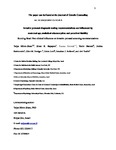Invasive Prenatal Diagnostic Testing Recommendations are Influenced by Maternal Age, Statistical Misconception and Perceived Liability.
| dc.contributor.author | Miron-Shatz, T | en |
| dc.contributor.author | Rapaport, SR | en |
| dc.contributor.author | Srebnik, N | en |
| dc.contributor.author | Hanoch, Y | en |
| dc.contributor.author | Rabinowitz, J | en |
| dc.contributor.author | Doniger, GM | en |
| dc.contributor.author | Levi, L | en |
| dc.contributor.author | Rolison, JJ | en |
| dc.contributor.author | Tsafrir, A | en |
| dc.date.accessioned | 2017-10-05T10:24:04Z | |
| dc.date.issued | 2017-06-14 | en |
| dc.identifier.uri | http://hdl.handle.net/10026.1/10011 | |
| dc.description.abstract |
Funding policy and medico-legal climate are part of physicians' reality and might permeate clinical decisions. This study evaluates the influence of maternal age and government funding on obstetrician/gynecologist recommendation for invasive prenatal testing (i.e. amniocentesis) for Down syndrome (DS), and its association with the physician's assessment of the risk of liability for medical malpractice unless they recommend amniocentesis. Israeli physicians (N = 171) completed a questionnaire and provided amniocentesis recommendations for women at 18 weeks gestation with normal preliminary screening results, identical except aged 28 and 37. Amniocentesis recommendations were reversed for the younger ('yes' regardless of testing results: 6.4%; 'no' regardless of testing results: 31.6%) versus older woman ('yes' regardless of testing results: 40.9%; 'no' regardless of testing results: 7.0%; χ(2) = 71.55, p < .01). About half of the physicians endorsed different recommendations per scenario; of these, 65.6% recommended amniocentesis regardless of testing results for the 37-year-old woman. Physicians routinely performing amniocentesis and those advocating for amniocentesis for all women ≥ age 35 were approximately twice as likely to vary their recommendations per scenario. Physicians who perceived risk of liability for malpractice as large were nearly one-and-a-half times more likely to vary recommendations. The results indicate physicians' recommendations are influenced by maternal age, though age is already incorporated in prenatal DS risk evaluations. The physician's assessment of the risk that they will be sued unless they recommend amniocentesis may contribute to this spurious influence. | en |
| dc.language.iso | en | en |
| dc.subject | Amniocentesis | en |
| dc.subject | Bias | en |
| dc.subject | Clinician recommendation | en |
| dc.subject | Decision making | en |
| dc.subject | Defensive medicine | en |
| dc.subject | Funding policy | en |
| dc.subject | Maternal age | en |
| dc.subject | Prenatal testing | en |
| dc.title | Invasive Prenatal Diagnostic Testing Recommendations are Influenced by Maternal Age, Statistical Misconception and Perceived Liability. | en |
| dc.type | Journal Article | |
| plymouth.author-url | https://www.ncbi.nlm.nih.gov/pubmed/28616831 | en |
| plymouth.publication-status | Published online | en |
| plymouth.journal | J Genet Couns | en |
| dc.identifier.doi | 10.1007/s10897-017-0120-9 | en |
| plymouth.organisational-group | /Plymouth | |
| plymouth.organisational-group | /Plymouth/REF 2021 Researchers by UoA | |
| plymouth.organisational-group | /Plymouth/REF 2021 Researchers by UoA/UoA04 Psychology, Psychiatry and Neuroscience | |
| plymouth.organisational-group | /Plymouth/Research Groups | |
| plymouth.organisational-group | /Plymouth/Research Groups/Centre for Brain, Cognition and Behaviour (CBCB) | |
| plymouth.organisational-group | /Plymouth/Research Groups/Centre for Brain, Cognition and Behaviour (CBCB)/Behaviour | |
| dcterms.dateAccepted | 2017-05-30 | en |
| dc.rights.embargodate | 2018-06-18 | en |
| dc.identifier.eissn | 1573-3599 | en |
| dc.rights.embargoperiod | Not known | en |
| rioxxterms.versionofrecord | 10.1007/s10897-017-0120-9 | en |
| rioxxterms.licenseref.uri | http://www.rioxx.net/licenses/all-rights-reserved | en |
| rioxxterms.licenseref.startdate | 2017-06-14 | en |
| rioxxterms.type | Journal Article/Review | en |


